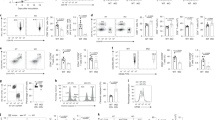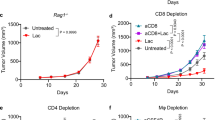Abstract
4-1BB (CD137) is a strong enhancer of the proliferation of CD8+ T cells. Since these cells require increased production of energy and biomass to support their proliferation, we hypothesized that 4-1BB signaling activated glucose and fatty acid metabolism. We found that treatment with agonistic anti-4-1BB mAb promoted the proliferation of CD8+ T cells in vitro, increasing their size and granularity. Studies with a glycolysis inhibitor and a fatty acid oxidation inhibitor revealed that CD8+ T cell proliferation required both glucose and fatty acid metabolism. Anti-4-1BB treatment increased glucose transporter 1 expression and activated the liver kinase B1 (LKB1)-AMP-activated protein kinase (AMPK)-acetyl-CoA carboxylase (ACC) signaling pathway, which may be responsible for activating the metabolism of glucose and fatty acids. We also examined whether blocking glucose or fatty acid metabolism affected cell cycle progression and the anti-apoptotic effect of 4-1BB signaling. The increase of anti-apoptotic factors and cyclins in response to anti-4-1BB treatment was completely prevented by treating CD8+ T cells with the fatty acid oxidation inhibitor, etomoxir, but not with the glycolysis inhibitor, 2-deoxy-D-glucose. We conclude that anti-4-1BB treatment activates glucose and fatty acid metabolism thus supporting the increased demand for energy and biomass, and that fatty acid metabolism plays a crucial role in enhancing the cell cycle progression of anti-CD3-activated CD8+ T cells in vitro and the anti-apoptotic effects of 4-1BB signaling on these cells.
This is a preview of subscription content, access via your institution
Access options
Subscribe to this journal
Receive 12 digital issues and online access to articles
$119.00 per year
only $9.92 per issue
Buy this article
- Purchase on Springer Link
- Instant access to full article PDF
Prices may be subject to local taxes which are calculated during checkout






Similar content being viewed by others
References
Hurtado JC, Kim SH, Pollok KE, Lee ZH, Kwon BS . Potential role of 4-1BB in T cell activation. Comparison with the costimulatory molecule CD28. J Immunol 1995; 155: 3360–3367.
Choi BK, Bae JS, Choi EM, Kang WJ, Sakaguchi S, Vinay DS et al. 4-1BB-dependent inhibition of immunosuppression by activated CD4+CD25+ T cells. J Leukoc Biol 2004; 75: 785–791.
Vinay DS, Kwon BS . 4-1BB signaling beyond T cells. Cell Mol Immunol 2011; 8: 281–284.
Wang C, Lin GH, McPherson AJ, Watts TH . Immune regulation by 4-1BB and 4-1BBL: complexities and challenges. Immunol Rev 2009; 229: 192–215.
Lee SW, Vella AT, Kwon BS, Croft M . Enhanced CD4 T cell responsiveness in the absence of 4-1BB. J Immunol 2005; 174: 6803–6808.
Kwon BS, Hurtado JC, Lee ZH, Kwack KB, Seo SK, Choi BK et al. Immune responses in 4-1BB (CD137)-deficient mice. J Immunol 2002; 168: 5483–5490.
van der Windt GJ, Pearce EL . Metabolic switching and fuel choice during T-cell differentiation and memory development. Immunol Rev 2012; 249: 27–42.
Gerriets VA, Rathmell JC . Metabolic pathways in T cell fate and function. Trends Immunol 2012; 33: 168–173.
Wang R, Green DR . Metabolic checkpoints in activated T cells. Nat Immunol 2012; 13: 907–915.
Pearce EL, Pearce EJ . Metabolic pathways in immune cell activation and quiescence. Immunity 2013; 38: 633–643.
Cham CM, Driessens G, O'Keefe JP, Gajewski TF . Glucose deprivation inhibits multiple key gene expression events and effector functions in CD8+ T cells. Eur J Immunol 2008; 38: 2438–2450.
van der Windt GJ, Everts B, Chang CH, Curtis JD, Freitas TC, Amiel E et al. Mitochondrial respiratory capacity is a critical regulator of CD8+ T cell memory development. Immunity 2012; 36: 68–78.
Pearce EL, Walsh MC, Cejas PJ, Harms GM, Shen H, Wang LS et al. Enhancing CD8 T-Cell memory by modulating fatty acid metabolism. Nature 2009; 460: 103–107.
Araki K, Turner AP, Shaffer VO, Gangappa S, Keller SA, Bachmann MF et al. mTOR regulates memory CD8 T-cell differentiation. Nature 2009; 460: 108–112.
Sukumar M, Liu J, Ji Y, Subramanian M, Crompton JG, Yu Z et al. Inhibiting glycolytic metabolism enhances CD8+ T cell memory and antitumor function. J Clin Invest 2013; 123: 4479–4488.
Lee HW, Nam KO, Park SJ, Kwon BS . 4-1BB enhances CD8+ T cell expansion by regulating cell cycle progression through changes in expression of cyclins D and E and cyclin-dependent kinase inhibitor p27kip1. Eur J Immunol 2003; 33: 2133–2141.
Lee HW, Nam KO, Seo SK, Kim YH, Kang H, Kwon BS . 4-1BB cross-linking enhances the survival and cell cycle progression of CD4 T lymphocytes. Cell Immunol 2003; 223: 143–150.
Hurtado JC, Kim YJ, Kwon BS . Signals through 4-1BB are costimulatory to previously activated splenic T cells and inhibit activation-induced cell death. J Immunol 1997; 158: 2600–2609.
Oh HS, Choi BK, Kim YH, Lee DG, Hwang S, Lee MJ et al. 4-1BB signaling enhances primary and secondary population expansion of CD8+ T cells by maximizing autocrine IL-2/IL-2 receptor signaling. PLoS One 2015; 10: e0126765.
Maclver NJ, Blagih J, Saucillo DC, Tonelli L, Griss T, Rathmell JC et al. The liver kinase B1 is a central regulator of T cell development, activation, and metabolism. J Immunol 2011; 187: 4187–4198.
Hostetler HA, Lupas D, Tan Y, Dai J, Kelzer MS, Martin GG et al. Acyl-CoA binding proteins interact with the acyl-CoA binding domain of mitochondrial carnitine palmitoyl transferase I. Mol Cell Biochem 2011; 355: 135–148.
Shriver LP, Manchester M . Inhibition of fatty acid metabolism ameliorates disease activity in an animal model of multiple sclerosis. Sci Rep 2011; 1: 79.
Kola B, Grossman AB, Korbonits M . The role of AMP-activated protein kinase in obesity. Front Horm Res 2008; 36: 198–211.
O'Neill HM . AMPK and exercise: Glucose uptake and insulin sensitivity. Diabetes Metab J 2013; 37: 155.
Shackelford DB, Shaw RJ . The LKB1-AMPK pathway: metabolism and growth control in tumour suppression. Nat Rev Cancer 2009; 9: 563–575.
Abu-Elheiga L, Matzuk MM, Abo-Hashema KA, Wakil SJ . Continuous fatty acid oxidation and reduced fat storage in mice lacking acetyl-CoA carboxylase 2. Science 2001; 291: 2613–2616.
Hawley SA, Pan DA, Mustard KJ, Ross L, Bain J, Edelman AM et al. Calmodulin-dependent protein kinase kinase-beta is an alternative upstream kinase for AMP-activated protein kinase. Cell Metab 2005; 2: 9–19.
Woods A, Dickerson K, Heath R, Hong SP, Momcilovic M, Johnstone SR et al. Ca2þ/calmodulin-dependent protein kinase kinase-beta acts upstream of AMP-activated protein kinase in mammalian cells. Cell Metab 2005; 2: 21–33.
Premack BA, Gardner P . Signal transduction by T-cell receptors: mobilization of Ca and regulation of Ca-dependent effector molecules. Am J Physiol 1992; 263: C1119–C1140.
Rathmell JC, Vander Heiden MG, Harris MH, Frauwirth KA, Thompson CB . In the absence of extrinsic signals, nutrient utilization by lymphocytes is insufficient to maintain either cell size or viability. Mol Cell 2000; 6: 683–692.
Krauss S, Brand MD, Buttgereit F . Signaling takes a breath—new quantitative perspectives on bioenergetics and signal transduction. Immunity 2001; 15: 497–502.
Lin GH, Liu Y, Ambagala T, Kwon BS, Ohashi PS, Watts TH . Evaluating the cellular targets of anti-4-1BB agonist antibody during immunotherapy of a pre-established tumor in mice. PLoS One 2010; 5: e11003.
Itzhaki O, Hovav E, Ziporen Y, Levy D, Kubi A, Zikich D et al. Establishment and large-scale expansion of minimally cultured "young" tumor infiltrating lymphocytes for adoptive transfer therapy. J Immunother 2011; 34: 212–220.
Long AH, Haso WM, Shern JF, Wanhainen KM, Murgai M, Ingaramo M et al. 4-1BB costimulation ameliorates T cell exhaustion induced by tonic signaling of chimeric antigen receptors. Nat Med 2015; 21: 581–590.
Gattinoni L, Klebanoff CA, Restifo NP . Pharmacologic induction of CD8+ T cell memory: better living through chemistry. Sci Transl Med 2009; 1: 11ps12.
Kung C, Thomas ML . Recent advances in lymphocyte signaling and regulation. Front Biosci 1997; 2: d207–d221.
Xiao B, Sanders MJ, Underwood E, Heath R, Mayer FV, Carmena D et al. Structure of mammalian AMPK and its regulation by ADP. Nature 2011; 472: 230–233.
Corredetti MN, Inoki K, Bardeesy N, DePinho RA, Guan KL . Regulation of the TSC pathway by LKB1: evidence of a molecular link between tuberous sclerosis complex and Peutz-Jeghers syndrome. Genes Dev 2004; 18: 1533–1538.
Shaw RJ, Bardeesy N, Manning BD, Lopez L, Kosmatka M, DePinho RA et al. The LKB1 tumor suppressor negatively regulates mTOR signaling. Cancer Cell 2004; 6: 91–99.
Mihaylova MM, Shaw RJ . The AMPK signalling pathway coordinates cell growth, autophagy and metabolism. Nat Cell Biol 2011; 13: 1016–1023.
Oestreich KJ, Read KA, Gilbertson SE, Hough KP, McDonald PW, Krishnamoorthy V et al. Bcl-6 directly represses the gene program of the glycolysis pathway. Nat Immunol 2014; 15: 957–964.
Acknowledgements
This work was funded by grants from the National Cancer Center of Korea (NCC-1310430), the National Research Foundation of Korea (NRF-2005-0093837, NRF-2013R1A1A2008703), the Korea Drug Development Fund (KDDF-201408-11) and the Ministry of Trade, Industry and Energy of Korea (GLOBAL R&D PROJECT, N0000901).
Author information
Authors and Affiliations
Corresponding author
Ethics declarations
Competing interests
The authors declare no conflict of interest.
Additional information
Supplementary Information for this article can be found on the Cellular & Molecular Immunology website
Supplementary information
Rights and permissions
About this article
Cite this article
Choi, B., Lee, D., Lee, D. et al. 4-1BB signaling activates glucose and fatty acid metabolism to enhance CD8+ T cell proliferation. Cell Mol Immunol 14, 748–757 (2017). https://doi.org/10.1038/cmi.2016.02
Received:
Revised:
Accepted:
Published:
Issue Date:
DOI: https://doi.org/10.1038/cmi.2016.02
Keywords
This article is cited by
-
CD8+ T cell priming that is required for curative intratumorally anchored anti-4-1BB immunotherapy is constrained by Tregs
Nature Communications (2024)
-
4-1BB immunotherapy: advances and hurdles
Experimental & Molecular Medicine (2024)
-
Exploiting innate immunity for cancer immunotherapy
Molecular Cancer (2023)
-
Targeting mitochondrial metabolism for precision medicine in cancer
Cell Death & Differentiation (2022)
-
The therapeutic implications of immunosuppressive tumor aerobic glycolysis
Cellular & Molecular Immunology (2022)



